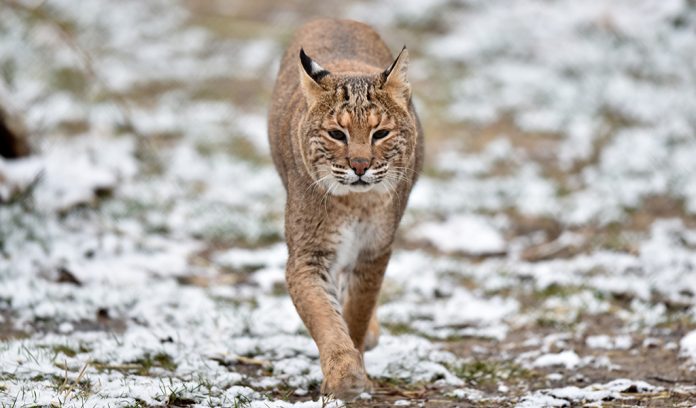
Every morning, I take my two dogs on the same walk through the woods down to the creek. It never seems mundane to me; I love the predictability of a morning routine. I walk by the same trees on the same trail every single day.
The dogs will not let me forget this one very crucial start to my day. If I am running behind schedule, they are crazy and disrupt every other task I attempt.
One day last week, my very simple walk suddenly required some research before I went out on the trail. Our neighbor had captured an unexpected visitor with his trail camera. It was a bobcat sniffing around in the woods.
Bobcat research
At first, I Googled, “Do bobcats attack people?” Then I followed up with, “Do bobcats attack dogs?”
To answer my research questions, bobcats are normally shy animals. They do not initiate contact with humans. Attacks on humans are extremely rare. They can be aggressive and attack if they have rabies or are sick.
Bobcats might be attracted to pet food left outside, but in general, it is also highly unlikely for a bobcat to attack pets.
We have not seen bobcats in our woods before or on our trail camera photos either. While they are new to our area, they are not new to Ohio.
Once common to the state, bobcats were considered extirpated by 1850. Sightings were rare until the last decade. After a resurgence, bobcats were removed from the list of Ohio endangered and threatened species in July of 2014.
Wildcats
Bobcats are one of six species of wildcats native to North America. In addition to the bigger jaguars and cougars, other smaller wildcat species include the ocelot, jaguarundi and Canadian lynx.
These species do have some behaviors in common. Just like barn cats, they are skillful at ambushing smaller animals. They crouch down low in stealth mode before a sneak attack and pounce on their unsuspecting prey.
Their retractable claws are helpful in hunting and aid in their climbing ability. In the wild, their lean and muscular bodies make them exceptional at jumping. Similar to barn cats, wildcats prefer a solitary lifestyle and are typically nocturnal.
It is rare for a jaguar to be spotted in the United States, but they once roamed from California to Texas. Jaguars were almost entirely wiped out from the United States.
In 1963, the last known female Jaguar was shot by a hunter in the White Mountains of Arizona. Most recently, several males have been seen across the Mexico border in southeastern Arizona on federally owned land.
Cougars are smaller than jaguars but known by many more names. They have been called mountain lions, pumas and panthers. These monikers all refer to the Puma concolor, the largest of the small cats.
Cougars have a huge range, from northern British Columbia to Argentina. They can thrive in multiple habitats including forests, prairies swamps, and even deserts.
Cougars once roamed in all 48 continental states. Now, according to The Cougar Fund, there are viable breeding cougar populations in only 16 states. These states are in the western United States with the exception of Florida.
Sightings
Many Ohio and Indiana residents have reported seeing large cats that fit the description of a cougar. Without proof, such as a legitimate trail camera picture or a carcass from a traffic incident, these claims are mostly invalidated.
Last spring, my son had a wild story after he sat in the woods watching for turkey. He had hoped to see a large tom trotting through the trees. Instead, he was surprised to see what he described as a very large, black cat with a long tail.
My first thought was that it could have been a bobcat. He insisted it looked like a puma or a black panther. He explained that it had a large body with a long tail. We all had a good chuckle as he retold the story several times. However, I am not one to tell other people what they did or did not see.
Melanism is defined as an increased amount of black or nearly black pigmentation. It is a rare genetic mutation. Black panthers are actually black-coated jaguars or leopards. Melanism has also been seen in bobcats.
He likes to tell exaggerated stories; I like to look at the odds of a rare event happening. I think I’m more likely to win the lottery than see a melanistic mountain lion or bobcat running in our woods.
I have never bought a lottery ticket, but I will grab onto the wishbone after Thanksgiving dinner and hope to have my wish granted.












